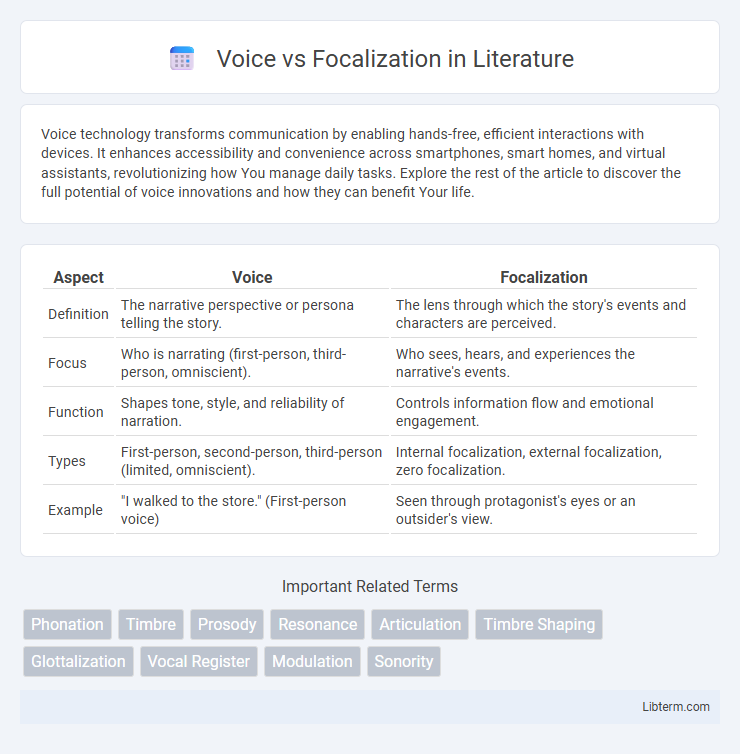Voice technology transforms communication by enabling hands-free, efficient interactions with devices. It enhances accessibility and convenience across smartphones, smart homes, and virtual assistants, revolutionizing how You manage daily tasks. Explore the rest of the article to discover the full potential of voice innovations and how they can benefit Your life.
Table of Comparison
| Aspect | Voice | Focalization |
|---|---|---|
| Definition | The narrative perspective or persona telling the story. | The lens through which the story's events and characters are perceived. |
| Focus | Who is narrating (first-person, third-person, omniscient). | Who sees, hears, and experiences the narrative's events. |
| Function | Shapes tone, style, and reliability of narration. | Controls information flow and emotional engagement. |
| Types | First-person, second-person, third-person (limited, omniscient). | Internal focalization, external focalization, zero focalization. |
| Example | "I walked to the store." (First-person voice) | Seen through protagonist's eyes or an outsider's view. |
Understanding Voice and Focalization
Voice refers to the narrative perspective in which a story is told, distinguishing between first-person, second-person, and third-person narrations, influencing how information and emotions are conveyed. Focalization centers on the lens through which the narrative is experienced, determining whose thoughts, feelings, and perceptions shape the story, whether internal or external. Understanding the distinction clarifies how narratives manipulate reader alignment and interpretive depth by controlling perspective and access to knowledge.
Defining Voice in Narrative
Voice in narrative refers to the distinctive style, tone, and personality an author or narrator uses to tell a story, shaping the reader's perception and emotional engagement. It encompasses the choice of words, sentence structure, and rhythm, reflecting the narrator's or character's worldview and biases. Voice establishes a unique narrative presence that differentiates one storyteller from another within literary works.
Defining Focalization in Storytelling
Focalization in storytelling refers to the perspective through which a narrative's events and experiences are presented, shaping how readers perceive characters and plot developments. Unlike voice, which encompasses the narrator's unique style and tone, focalization determines whose viewpoint filters the story, influencing the emotional and cognitive access to narrative information. Understanding focalization allows for deeper analysis of narrative techniques, highlighting shifts between internal and external perspectives that impact reader engagement and interpretation.
Key Differences between Voice and Focalization
Voice refers to the grammatical relationship between the subject and the action of the verb, distinguishing active, passive, and middle constructions, whereas focalization relates to the perspective or point of view through which a narrative is presented. Voice emphasizes who is performing or receiving the action, impacting sentence structure and clarity, while focalization shapes the reader's access to thoughts, perceptions, and emotions of characters or narrators. Understanding these distinctions enhances comprehension of narrative techniques and syntactic alignment in linguistics and literary studies.
Types of Narrative Voices
Narrative voices can be categorized primarily into first-person, second-person, and third-person perspectives, each influencing the narrative focalization differently. First-person voice offers internal focalization through the narrator's personal experiences, while third-person can provide variable focalization, shifting among characters' thoughts and perceptions. Second-person voice, often less common, creates an immersive focal point by directly addressing the reader as the protagonist, blending narrative voice with focalization uniquely.
Types of Focalization
Types of focalization in narrative theory include zero, internal, and external focalization, each defining who perceives the events within the story. Zero focalization occurs when the narrator has an omniscient point of view, knowing more than the characters. Internal focalization limits the perspective to the sensory and mental experience of a single character, while external focalization restricts the narrative to observable behaviors and actions without access to inner thoughts.
Effects of Voice on Reader Experience
Voice shapes the reader's connection to the narrative by providing a distinct personality and tone, influencing emotional engagement and immersion. The choice between first-person, third-person, or omniscient voice alters the level of intimacy and reliability perceived by the audience. Variations in voice impact pacing and mood, guiding readers' interpretation and fostering a unique storytelling experience.
Role of Focalization in Perspective Control
Focalization plays a crucial role in perspective control by determining through whose consciousness or viewpoint the narrative is filtered, influencing how readers perceive events and characters. Unlike voice, which concerns the narrator's identity and reliability, focalization directs attention to the angle of perception, shaping the subjective experience within the story. This mechanism allows authors to manipulate information flow, control emotional engagement, and frame interpretation by selecting internal, external, or zero focalization.
Common Pitfalls: Confusing Voice with Focalization
Confusing voice with focalization often leads to misunderstanding narrative perspective versus grammatical structure. Voice refers to the relationship between the subject and verb, such as active or passive, while focalization concerns the lens through which a story is perceived, typically aligning with a character's point of view. Overlooking this distinction results in misinterpreting narrative techniques and character insight in literary analysis.
Choosing the Right Approach for Your Story
Selecting the right narrative technique between voice and focalization depends on the desired intimacy and perspective in your story. Voice shapes the overall tone and personality conveyed through the narrator's consistent style, influencing reader connection. Focalization controls the viewpoint through which events are filtered, allowing precise manipulation of knowledge and emotional engagement within scenes.
Voice Infographic

 libterm.com
libterm.com